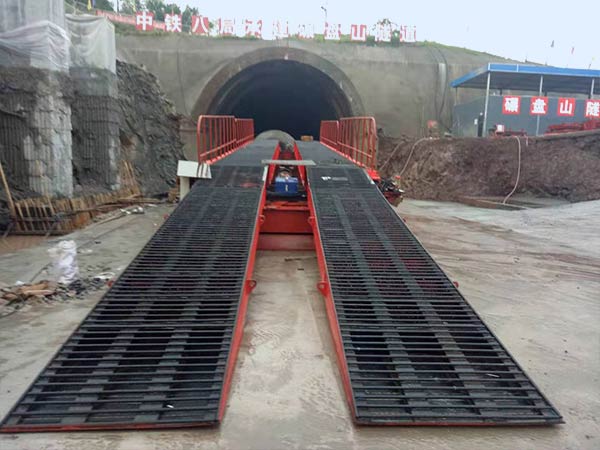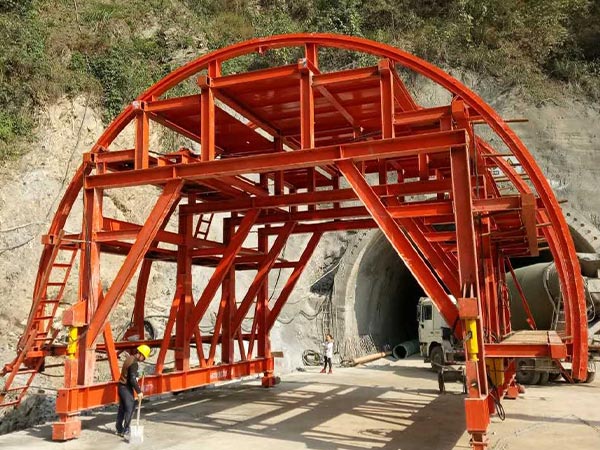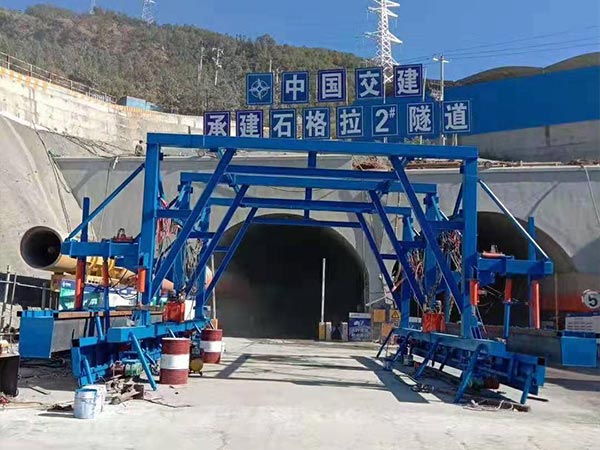Self-propelled hydraulic inverting bridge formwork construction steps
The self-propelled hydraulic inverting bridge formwork adopts mechatronics and hydraulic integration design, equipped with multi-functional automatic walking device, front support, rear lateral movement mechanism, hydraulic self-balancing system, which can realize automatic vertical movement, rise and fall, and automatic horizontal movement, with a high degree of automation , Can adapt to a variety of construction work environment.
The self-propelled hydraulic inverting bridge formwork is composed of the main body of the trestle bridge, hydraulic system, electrical control system, and walking system.
The main structure of the main bridge: 8 40b# I-beams are arranged in parallel along the longitudinal direction of the tunnel at the bottom of the bridge, 4 20# channel steels and 6 20b# I-beams are arranged horizontally along the tunnel on the bottom of the bridge, with box-shaped structures on both sides and the middle 25# I-shaped steel support connection. The hydraulic system includes various lifting cylinders and related hydraulic pump stations and pipelines; the electrical system is responsible for controlling the operation of each system, mainly composed of various relays, switches, circuit breakers, etc.
The traveling system is composed of a motor reducer, a transmission chain, a box body, a traveling wheel, etc. There are 4 groups, which are respectively placed on both sides of the end of the trestle body to realize the automatic walking of the trestle body. The walking device can realize horizontal and vertical walking, which is flexible and convenient.
Hydraulic inverting bridge formwork walking principle
In order to meet the requirements of movement, a mobile walking mechanism is set at both ends of the trestle bridge, and a limit warning device is set; when walking, the lifting and lowering of the slope bridge at both ends of the trestle bridge is completed by the hydraulic system actuator. The self-propelled hydraulic inverting bridge formwork is mainly composed of the main bridge, traveling device, hydraulic system, electrical system, limit device and alarm system. The trestle bridge is moved. When moving, it is driven by a motor and driven by a gear pinion to drive the walking wheel to move on the walking track. The working steps are as follows:

Start the main bridge lifting cylinder installed at the end of the trestle bridge to make the trestle bridge slope off the ground, and then with the cooperation of workers, drag the trestle bridge walking track forward. After the track is dragged to the end, shrink the main bridge lifting cylinder to start the traveling motor. The trestle moves forward on the track, after moving to the end of the track, repeat the above steps until the trestle is in place (the trestle’s lateral movement is the same as this). After the trestle bridge is in place, the main bridge lifting cylinder is lifted up, so that the running wheels are not stressed. After being fixed, the front and rear slope bridges are put down.
Hydraulic inverting bridge formwork construction technology
According to the requirements of the construction schedule, the construction of the tunnel entering the invert position, in order to ensure that the invert construction continues and the slag from the tunnel excavation and the transportation of materials in the tunnel are not affected by the invert excavation, so the invert excavation slot is installed the trestle bridge will be constructed. After the strength of the poured invert concrete meets the traffic strength requirements, the trestle bridge can be pushed forward to the excavation groove at the bottom of the next tunnel, and then recycled. So as to realize the rapid and safe progress of tunnel construction.
Trestle installation and positioning
Plan ahead of time the personnel, materials and machinery required for processing. The installation of the trestle is carried out by professional and technical personnel. When the hydraulic inverting bridge formwork is erected, the bottom slag of the front platform of the trestle must be removed before the trestle is advanced, and the foundation must have a certain bearing capacity. The back end is laid on the top surface of the filling; the front ramp of the trestle bridge should be firmly connected with the trestle platform to ensure the safety of erection. After the trestle bridge is erected and installed in place, safety nets must be hung outside the guardrails on both sides of the trestle bridge to prevent the falling of gravel from hurting the operators of the inverted arch construction below; obvious slow-moving warning signs should be set at the front and rear of the trestle bridge, and the trestle bridge surface should have anti-skid measures.

Trestle inspection
Before the trestle bridge is moved, erected and installed, the welding parts of the trestle bridge shall not have the phenomenon of welding seam falling off or welding seam cracking, and the supporting system shall be inspected to check whether the main beam and auxiliary components of the trestle bridge are cracked and deformed. If problems are found, the trestle shall not be carried out. Moving and erecting, the trestle can be moved and erected only after the processing is completed and the inspection is qualified.
Trestle move
Use an excavator or loader to set it in place, and walk on its own after it is in place: the inverted arch can only be moved after the strength of the filled concrete reaches the design requirements and the necessary protective measures must be taken. The movement must be slow to avoid damage to the quality of the finished concrete: trestle bridge When moving, full-time personnel must be assigned to uniformly command, and no one is allowed to stand in the trestle work area.
Invert excavation
(1) The invert excavation is divided into left and right parts, and half of the excavation is carried out first.
(2) In the first cycle, first excavate the left or right inverted arch, and park the trestle on the side where there is no excavation: park the slag truck on the trestle, and excavate the excavator on the surface to be excavated When excavating from the front to the rear of the trestle bridge, the excavator has been parked on the elevation surface of the inverted arch, so as to ensure that the excavator can load the slag into the slag truck.
(3) After excavating one side, operate the trestle bridge to move the trestle bridge to the side that has been excavated, and also park the slag truck on the trestle bridge, and the excavator will excavate on the surface to be excavated. When excavating from the front end to the back end of the trestle bridge, the excavator has been stopped on the elevation surface of the invert, so as to ensure that the excavator can load the slag into the slag truck; at this time, the invert excavation and the invert lining can be carried out simultaneously.
(4) Repeat the above process to complete the next cycle of invert construction.
Advantages of hydraulic trestle
(1) Through the application of the trestle bridge in the tunnel, the materials and tools for the construction of the tunnel face can pass from the upper part of the trestle bridge, reducing the interference between excavation construction and invert construction: at the same time, the trestle bridge has a large span and is an inverted arch The construction provides a streamlined work surface: the trestle itself is convenient and quick to install, walks more flexible, and has a high level of mechanization. These are conducive to speeding up the tunnel construction speed and solving the schedule problem, especially for the long tunnel and the tight construction period, the benefit of ensuring the schedule is very obvious.
(2) Compared with the simple trestle bridge, the use of movable hydraulic inverting bridge formwork, although the cost of manufacturing or purchase increases, but because it provides enough space for inverting operations, it can effectively organize flow construction. Improve production efficiency and speed up, especially in the case of long tunnels, which will play a role in reducing engineering costs.
(3) Ensure the safety of construction workers under the trestle bridge. The hydraulic inverting bridge formwork made of section steel is stable in structure, safe and reliable; the mobile trestle reduces the interference between working procedures, and the structural safety is improved compared with the simple trestle.
(4) It is beneficial to ensure the quality of tunnel construction. Due to the use of the trestle bridge, it is guaranteed that the invert is poured in one time, which is beneficial to ensure the quality of the invert.

Precautions when using self-propelled hydraulic inverting bridge formwork
(1) Personnel operating the trestle bridge must be trained and qualified before they can carry out operations.
(2) When the hydraulic inverting bridge formwork is in place, pay attention to the flatness of the installation and the width of the installation to meet the design requirements to ensure the safety of the vehicle and the normal passage of vehicles with different wheel bases.
(3) The speed limit for vehicles passing through the trestle bridge should be determined according to the actual situation on site to ensure the stability and safety of the hydraulic inverting bridge formwork during work: construction personnel are prohibited from passing vehicles when working under the trestle bridge to ensure the safety of operators.
(4) Lay safety nets on the outside of the trusses on both sides of the trestle bridge to prevent the falling of gravel from hurting the construction operators below. The concrete and debris on the self-propelled hydraulic inverting bridge formwork should be cleaned up in time to keep the upper part of the trestle clean.
Concluding remarks
The application of hydraulic trestle has changed the existing tunnel invert construction organization mode. Under the premise of not affecting the tunnel face construction, the tunnel invert excavation, reinforcement binding, invert pouring and other operations are carried out at the same time to realize the excavation and invert the parallel operation of arch construction greatly saves construction time and improves the overall efficiency of tunnel construction.
Due to the automatic walking device, the trouble of manually moving the trestle bridge is reduced, the automation level of tunnel construction is improved, and the safety is enhanced. Become the technical basis for ensuring the quality, schedule, and cost control of the tunnel invert construction, and the technical basis for realizing the standardization of tunnel construction and the construction of humanized and civilized construction sites.















